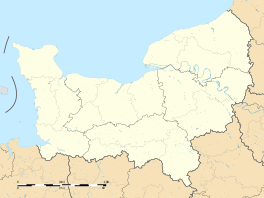Écouché
| Écouché | ||
|---|---|---|
|
||
| Coordinates: 48°43′05″N 0°07′25″W / 48.718°N 0.1236°WCoordinates: 48°43′05″N 0°07′25″W / 48.718°N 0.1236°W | ||
| Country | France | |
| Region | Normandy | |
| Department | Orne | |
| Arrondissement | Argentan | |
| Canton | Magny-le-Désert | |
| Government | ||
| • Mayor (2001–2008) | Jean-Pierre Latron | |
| Area1 | 5.22 km2 (2.02 sq mi) | |
| Population (2012)2 | 1,323 | |
| • Density | 250/km2 (660/sq mi) | |
| Time zone | CET (UTC+1) | |
| • Summer (DST) | CEST (UTC+2) | |
| INSEE/Postal code | 61153 /61150 | |
| Elevation | 147–184 m (482–604 ft) | |
|
1 French Land Register data, which excludes lakes, ponds, glaciers > 1 km² (0.386 sq mi or 247 acres) and river estuaries. 2Population without double counting: residents of multiple communes (e.g., students and military personnel) only counted once. |
||
1 French Land Register data, which excludes lakes, ponds, glaciers > 1 km² (0.386 sq mi or 247 acres) and river estuaries.
Écouché is a former commune in the Orne department in north-western France. On 1 January 2016, it was merged into the new commune of Écouché-les-Vallées.
Écouché stands out today for the monumental church, a very rare Republican altar, several medieval merchants' houses, a number of original towers, a network of well-conserved lanes and – a reminder of the ordeal of World War II and the Liberation – a Sherman assault tank.
Écouché is the administrative centre of a canton in the Sub-Prefecture of Argentan, which starts just six kilometres away. Not so long ago, the population of the two towns' respective inhabitants were more equal.
Church
Revolution Altar to Reason
Halle
Towers
Medieval porticos
Mossadi Sherman tank
The origin of human settlement remains obscure. It can be supposed that the Gauls(Celts) and the Gallo-Romans recognised the advantages of the site, but the earliest written documents available that mention SCOTETUM date only from 1066 (a grant of tithes from Gacé and Écouché by William the Conqueror to his wife Mathilda at the Ladies' Abbey (Abbaye aux Dames ) in Caen).
The place-name later evolved to Escocheum, Escochie, Escouche and finally Écouché.
Disputes have arisen over the origin of the name, but the more classical version is that it started with a man's name of SCOTTIUS followed by the Latin possessive suffix ACUS, meaning "the property of Scottius". This implies a Roman origin
The description of Écouché as a CASTRUM found in 12th century charters is a form of language indicating a "ville bateice", meaning a town without walls, fortified only with palissades and featuring a wooden stronghold atop the feudal mound or motte and bailey (motte castral, motte feudal).
The Écouché palissades, however, were reinforced with a belt of water, or moat, made up of the natural rivers and some ditches filled with water from the rivers. As an example, the Angevine ditch was 8 metres (26 ft)wide and 1.80 metres (6 ft)deep. Defences like this trench were only useful against minor assaults like roving bands of unemployed soldiers or brigands. But the town kept its moats for a long time. They were in a bad state at the beginning of the 16th century and the inhabitants secured permission from King François I to raise a tax on the retail sale of drinks in order to restore the moats, and extend them towards the Udon marshes.
...
Wikipedia



